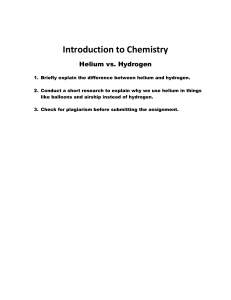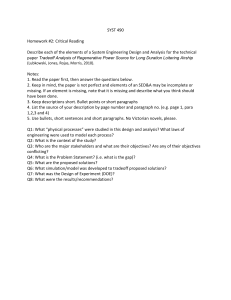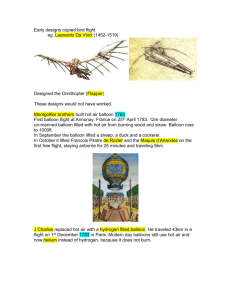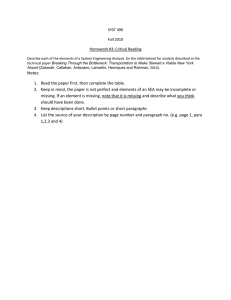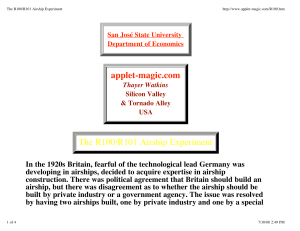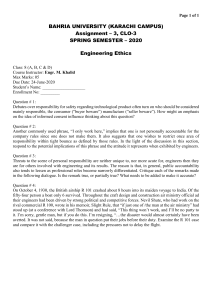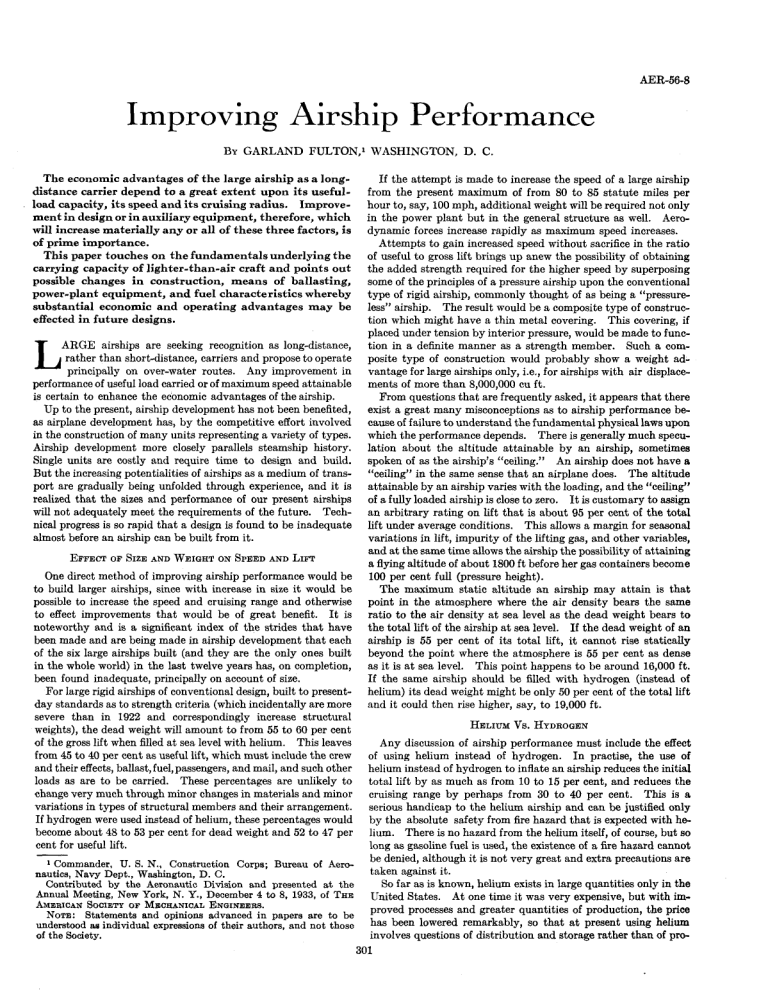
Im proving Airship Perform ance AER-56-8 By GARLAND FULTON,1 WASHINGTON, D. C. The economic advantages of the large airship as a long­ If the attempt is made to increase the speed of a large airship distance carrier depend to a great extent upon its useful- from the present maximum of from 80 to 85 statute miles per load capacity, its speed and its cruising radius. Improve­ hour to, say, 100 mph, additional weight will be required not only ment in design or in auxiliary equipment, therefore, which in the power plant but in the general structure as well. Aero­ will increase materially any or all of these three factors, is dynamic forces increase rapidly as maximum speed increases. of prime importance. Attempts to gain increased speed without sacrifice in the ratio This paper touches on the fundamentals underlying the of useful to gross lift brings up anew the possibility of obtaining carrying capacity of lighter-than-air craft and points out the added strength required for the higher speed by superposing possible changes in construction, means of ballasting, some of the principles of a pressure airship upon the conventional power-plant equipment, and fuel characteristics whereby type of rigid airship, commonly thought of as being a “pressuresubstantial economic and operating advantages may be less” airship. The result would be a composite type of construc­ effected in future designs. tion which might have a thin metal covering. This covering, if placed under tension by interior pressure, would be made to func­ ARGE airships are seeking recognition as long-distance, tion in a definite manner as a strength member. Such a com­ rather than short-distance, carriers and propose to operate posite type of construction would probably show a weight ad­ principally on over-water routes. Any improvement in vantage for large airships only, i.e., for airships with air displace­ performance of useful load carried or of maximum speed attainable ments of more than 8,000,000 cu ft. is certain to enhance the economic advantages of the airship. From questions that are frequently asked, it appears that there Up to the present, airship development has not been benefited, exist a great many misconceptions as to airship performance be­ as airplane development has, by the competitive effort involved cause of failure to understand the fundamental physical laws upon in the construction of many units representing a variety of types. which the performance depends. There is generally much specu­ Airship development more closely parallels steamship history. lation about the altitude attainable by an airship, sometimes Single units are costly and require time to design and build. spoken of as the airship’s “ceiling.” An airship does not have a But the increasing potentialities of airships as a medium of trans­ “ceiling” in the same sense that an airplane does. The altitude port are gradually being unfolded through experience, and it is attainable by an airship varies with the loading, and the “ceiling” realized that the sizes and performance of our present airships of a fully loaded airship is close to zero. It is customary to assign will not adequately meet the requirements of the future. Tech­ an arbitrary rating on lift that is about 95 per cent of the total nical progress is so rapid that a design is found to be inadequate lift under average conditions. This allows a margin for seasonal almost before an airship can be built from it. variations in lift, impurity of the lifting gas, and other variables, and at the same time allows the airship the possibility of attaining E f f e c t o f S iz e a n d W e i g h t o n S p e e d a n d L if t a flying altitude of about 1800 ft before her gas containers become One direct method of improving airship performance would be 100 per cent full (pressure height). to build larger airships, since with increase in size it would be The maximum static altitude an airship may attain is that possible to increase the speed and cruising range and otherwise point in the atmosphere where the air density bears the same to effect improvements that would be of great benefit. It is ratio to the air density at sea level as the dead weight bears to noteworthy and is a significant index of the strides that have the total lift of the airship at sea level. If the dead weight of an been made and are being made in airship development that each airship is 55 per cent of its total lift, it cannot rise statically of the six large airships built (and they are the only ones built beyond the point where the atmosphere is 55 per cent as dense in the whole world) in the last twelve years has, on completion, as it is at sea level. This point happens to be around 16,000 ft. been found inadequate, principally on account of size. If the same airship should be filled with hydrogen (instead of For large rigid airships of conventional design, built to present- helium) its dead weight might be only 50 per cent of the total lift day standards as to strength criteria (which incidentally are more and it could then rise higher, say, to 19,000 ft. severe than in 1922 and correspondingly increase structural H e l iu m Vs. H y d r o g e n weights), the dead weight will amount to from 55 to 60 per cent of the gross lift when filled at sea level with helium. This leaves Any discussion of airship performance must include the effect from 45 to 40 per cent as useful lift, which must include the crew of using helium instead of hydrogen. In practise, the use of and their effects, ballast, fuel, passengers, and mail, and such other helium instead of hydrogen to inflate an airship reduces the initial loads as are to be carried. These percentages are unlikely to total lift by as much as from 10 to 15 per cent, and reduces the change very much through minor changes in materials and minor cruising range by perhaps from 30 to 40 per cent. This is a variations in types of structural members and their arrangement. serious handicap to the helium airship and can be justified only If hydrogen were used instead of helium, these percentages would by the absolute safety from fire hazard that is expected with he­ become about 48 to 53 per cent for dead weight and 52 to 47 per lium. There is no hazard from the helium itself, of course, but so cent for useful lift. long as gasoline fuel is used, the existence of a fire hazard cannot denied, although it is not very great and extra precautions are 1 Commander, U. S. N., Construction Corps; Bureau of Aero­ be taken against it. nautics, Navy Dept., Washington, D. C. So far as is known, helium exists in large quantities only in the Contributed by the Aeronautic Division and presented at the Annual Meeting, New York, N. Y., December 4 to 8, 1933, of T h e United States. At one time it was very expensive, but with im­ A m e r ic a n S o c ie t y or M ec h a n ic a l E n g in e e r s . N o t e : Statements and opinions advanced in papers are to be proved processes and greater quantities of production, the price understood as individual expressions of their authors, and not those has been lowered remarkably, so that at present using helium of the Society. involves questions of distribution and storage rather than of pro301 L 302 TRANSACTIONS OF THE AMERICAN SOCIETY OF MECHANICAL ENGINEERS duction costs. It is expensive to transport helium, and steel con­ tainers for storing the gas under pressure are also expensive. But even considering these expenses and the additional one of occasionally repurifying the helium, it can be shown that the use of helium year in and year out is not more expensive than operation with hydrogen. Care is taken not to waste helium not so much because of the desire to preserve a valuable commodity as to avoid the difficulty of replenishing the supply at some remote point. E q u il ib r iu m B e t w e e n W e i g h t and B uoyancy In flight, an airship takes care of minor and even substantial variations in equilibrium through the use of her elevators. It is desirable, however, especially where the lifting gas should be con­ served, to enable the airship to maintain throughout the flight a reasonable balance between weight and buoyancy. The means adopted for this purpose in helium-filled American airships is an air-cooled condenser for recovering moisture from the engine exhaust. The use of this so-called “water-recovery apparatus” has involved many problems, notably those induced by the high temperature and corrosive nature of the exhaust products. Al­ though the apparatus now in use functions, it is heavy and not sufficiently durable. If airship performance is to improve, some more satisfactory solution to the problem of maintaining equi­ librium must be found. Airships are the only known agency that considers the exhaust products from an intemal-combustion en­ gine worth saving. Every other agency tries to get rid of them as promptly as possible. The essential results of burning ordinary gasoline in an internalcombustion engine can be written as a word equation: Gasoline + air = carbon monoxide + carbon dioxide + water. The water will be approximately 1.4 times, and the carbon dioxide nearly 4.0 times, the weight of the original gasoline. This invites consideration of the possibility of accumulating weight in flight through capturing in some way and retaining a portion of the carbon dioxide, but practical means of doing it within permissible weight allowances have not yet been discovered. Meanwhile, helium-filled airships continue to struggle with means for recovering water by condensing moisture from the exhaust. The results are influenced by composition of the fuel, by paucity of accurate data on thermodynamics of heat transfer under like conditions, and by mechanical and corrosion problems, as well as by the constant effort to reduce weight to a minimum and to avoid any unnecessary drag. Recovery of better than 115 per cent is frequently realized and an average of from 90 to 100 per cent is usually maintained. The problem of insuring that the necessarily large quantity of ballast water does not freeze in winter is a serious one and the solution now employed of carrying alcohol as an anti-freeze agent entails extra weight. As illustrating, perhaps by an extreme case, the handicap on airship performance imposed by water-recovery apparatus, con­ sider the case of a 6,500,000-cu ft airship equipped for a maximum endurance flight of six days’ duration in freezing temperatures. She will be forced to carry a weight of from 18 to 20 tons which could otherwise be devoted to useful fuel. This figure is made up as follows: Tons Water-recovery apparatus proper......................... 6.5 Bags and piping for recovered water.................... 1.5 Anti-freeze materials............................................... 6.0 Increased fuel consumption, due to increased drag caused by apparatus................................... 4.5 some other solution to the general problem of gaining weight during flight. Rain water can be easily captured if it is available. Water pick-up from the sea is another, and a very attractive, idea. The earliest water-recovery apparatus was a bucket thrown over the side. One of the most promising ideas is to place a quantity of cheap, readily available, hydrogen inside a mantle of helium and to valve out this hydrogen as the airship burns fuel and hence becomes lighter. A variation of this would be to bum some or all of the hydrogen instead of throwing it away. Still another solu­ tion, and a good one, is to use as fuel a gas having a density nearly that of air, so that burning fuel causes very little change in equilibrium. This type of fuel is now employed by the Graf Zeppelin. It is used there primarily because fuel gas having a high Btu value per pound is advantageous as a fuel and not espe­ cially because it avoids the necessity for valving out large quanti­ ties of lifting gas to maintain equilibrium as flight progresses. Another attractive idea for accumulating weight during flight is to recover moisture from the air, instead of from exhaust gases, and to do this by means of some hygroscopic substance from which the moisture can later be extracted by the application of heat, so as to allow the complete cycle to be carried out on board the airship. Several substances are available for consideration, but as yet none has been found that offers a definite solution with­ in a reasonable weight. E n g in e and P ow er-P lant I m provem ents The most potent effect on the performance of future airships will come through improvements in engines, engine installations, and general power-plant arrangements. At present these items represent about 20 to 25 per cent of the dead weight of the air­ ship. Existing power-plant weights on airships are abnormally high, this being the price paid for reliability and the result of a number of circumstances, many of which are in process of being improved or corrected. Relatively scant attention has been paid to the development of engines, propellers, and other power-plant appliances suited to the special requirements of airships. This situation seems all the more peculiar when it is realized that an airship is really an ex­ cellent flying laboratory for the general study of engine and pro­ peller performance. With the exception of high altitude and very high speed conditions, an airship is capable of providing all powerplant conditions that are essential to an airplane or an airship and to do this under conditions that permit almost complete accessi­ bility for adjustments, minor repairs, taking measurements or readings, and so on. Given time and more airships in operation, we should accumulate a mass of precise data on power-plant per­ formance, and with the analysis of these data there should be opened up avenues for improvements. It is to be hoped that eventually there will become available engine units satisfactory as to type and of a size ample to fit the requirements of a particular airship design. Airship sizes have increased far more rapidly than have the sizes of engines suitable for airship purposes. As a result, airship designers have been forced to such expedients as gearing two engines to a single pro­ peller or providing an excessively large number of power-plant units. Low S p e c if ic F u e l C o n s u m p t io n But aside from the weight of the engines themselves, low spe­ cific fuel consumption is of great importance, since the fuel load is by far the largest single item comprised in useful load and even a fractional saving in specific fuel consumption mounts into a siz­ able figure for long voyages. Considering the requirements of long cruising periods and the isTif necessity for reversing the direction of propeller thrust, and also This is a severe penalty and indicates the importance of finding the desirability of securing thrust in vertical directions, an airship AERONAUTICAL ENGINEERING power plant compares more nearly to that of a surface vessel than to the rather simple unidirection installations on airplanes. There is no fundamental reason why air-cooled engines cannot be employed for airships, especially to give that extra boost in power necessary to attain the highest speeds. A combination of a small number of air-cooled engines with liquid-cooled engines which are used at nearly full power for normal cruising has a number of advantages. Their relatively high fuel consumption would be an argument against a complete outfit of air-cooled engines. Arrangements for reversing and tilting propellers with air-cooled engines would be somewhat cumbersome, but might be made. An arrangement for mounting air-cooled engines on re­ tractable brackets has been seriously considered and could be made practical. Despite very serious efforts and the expenditure of large sums of money, there is not in existence today a light-weight, compressionignition, oil-burning engine that is really satisfactory for airship purposes, although there are several promising entries in the field. Such an engine is desired because of the decreased fire hazard which will result from using oil as fuel and the anticipated low specific fuel consumption. If a saving over gasoline of 25 per cent can be realized, it will amount to four or five tons for an average flight of 50 hours’ duration. Adequate water recovery from exhaust gas appears impracti­ cable with Diesel fuels because of the somewhat low hydrogen con­ tent of the fuel and still more because of the large excess of air over the theoretical requirements for combustion. When Diesel fuels are actually in use, airships will probably have to find some new solution to the weight accumulation problem or else be con­ tent with a rather heavy, low-efficiency water-recovery apparatus that yields only from 40 to 60 per cent instead of from 90 to 100 per cent in recovered weight. There has recently been much intensive work done in the de­ velopment and application of hydrogenated gasolines or so-called “safety fuels” f»r airship purposes. The use of fuels of this class holds promise of great benefit to airships. Successful operation with safety fuels appears at the moment to be nearer realization than successful operation with Diesel fuels. The most promis­ ing of the “safety fuels” from an airship standpoint have a flash point of about 130 F and cannot be used with present carburetors. They must be injected by means of a pump. Tests made with such fuels in existing engines indicate that their use will entail no loss in power, but fuel consumption may increase by a few per cent. The use of such fuels would result in a considerable reduction in the fire hazard which is present when gasoline is used. Despite their hydrogen content, these “safety fuels” are not well adapted to water recovery, but it does appear that they are better adapted to water recovery than Diesel oils and that a recovery of from 60 to 80 per cent might be realized from them under opti­ mum conditions. The German solution to the airship fuel question is in many ways ideal, but it unquestionably entails some increased risk over the use of Diesel oils or safety gasolines. This solution is to carry at atmospheric pressure a quantity of hydrocarbon gas having a density approximately equal to that of air and to burn this gase­ ous fuel in ordinary engines through the employment of a special type carburetor or mixing chamber. A small quantity of benzolgasoline is carried for use under certain conditions. The fuel gas serves neither as lifting gas nor as ballast and its consumption therefore does not involve much alteration in the airship’s balance between buoyancy and weight. Furthermore, the Btu value per pound is high. The whole arrangement results in an important gain in cruising range for the fuel-gas airship. This increase may be as much as 40 per cent more than the range of an airship using helium as the lifting gas and gasoline as fuel. AER-56-8 303 For an airship carrying hydrogen in any form—for lifting pur­ poses, or in ballonets as dischargeable “negative ballast”—the idea occurs, “Why not bum this hydrogen as fuel instead of merely exhausting it to the atmosphere?” A number of years ago before helium was available, serious efforts were devoted to using hydrogen as a fuel. A small Navy airship was equipped with hydrogen carburetors and made a successful flight from New York to Newfoundland, burning hydrogen and gasoline alternately. Recently, laboratory work by the National Ad­ visory Committee for Aeronautics has shown that hydrogen can be burned with high thermal efficiency and without the risk of backfiring that handicapped some of the earlier work along simi­ lar lines. The thermal efficiency of an engine running part on hydrogen and part on oil is less at low loads than that of a pure Diesel engine, but at high loads the efficiency is greater. It is believed conservative to estimate that with a Diesel-enginehydrogen-ballonet installation, and with water-recovery ap­ paratus eliminated, a gain of from 15 to 20 per cent in range can be realized through burning the hydrogen in conjunction with the fuel oil instead of wasting the hydrogen by valving to the atmosphere. The question of what added risk is involved through burning the hydrogen would have to be judged on the basis of final arrangements for conducting the hydrogen to the engines. A recent suggestion has been made that liquid hydrogen for fuel be carried in insulated spherical metal containers surrounded by helium. The hydrogen would be allowed to boil off as a vapor and be conducted to the engines. The mechanical features of the installation would not prove insurmountable or excessive as to weight, but questions of control of gas flow and safety as well as of the practical availability of liquid hydrogen, require investi­ gation. The cruising range of such an airship would be nearly twice that of our present gasoline-burning airships. Waterrecovery problems would be very much simplified. F ir e H a z a r d s Lest it be considered that the question of fire hazard has been over-emphasized in this discussion, it should be pointed out that there is a fire hazard in any craft that carries gasoline, either in bulk or as fuel. The fire hazard in airships on account of gasoline is not considered to be any greater than that existing in airplanes or motor boats. The question of fire hazard from hydrogen and from fuel gas is another matter, but here again the actual risk, assuming that the hydrogen purity is always well above the ex­ plosive range, is considered to be far less than is popularly be­ lieved. Perfection of interior mechanical arrangements and prudent operation of the airship and all her appliances are the greatest factors in reducing and eliminating fire hazards from whatever source, and all airship installations are very carefully worked out to eliminate these hazards. From the foregoing general and perhaps superficial discussion, it will be apparent that the performance of future airships is going to be very materially affected by the fuel adopted for use in their engines. There are several fuels which might be used—gaso­ line, “safety gasolines,” Diesel oils, fuel gas, hydrogen gas, liquid hydrogen. Each fuel will have its own peculiar effects on interior arrangements and may even influence noticeably the method of operation of the airship. A designer must trace the influence of possible fuels through all of their ramifications, and his choice, as usual, will have to be a compromise. The final comparison of the weight efficiency and performance of various alternative power-plant combinations and arrangements should be made on the basis of their performance over a considerable number of hours—say not less than 50 hr—since this figure respresents the average length of voyage for a modem airship.

